
Water cooler, Morton & Co., Brantford, Ontario, Canada, ca. 1850–1855. Salt‑glazed stoneware. H. 16 1/2". (Courtesy, Miller & Miller Auctions, Ltd.) Three examples of this cooler are known, all of them with slight differences but all decorated with the same cream glaze and similarly applied figures. One example is at the Royal Ontario Museum.
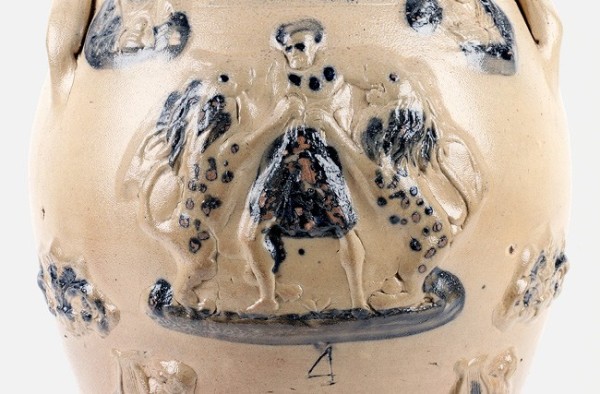
Detail of the molded and applied circus figure (probably the famed American lion tamer Isaac A. Van Amburgh) from the cooler illustrated in fig. 1.
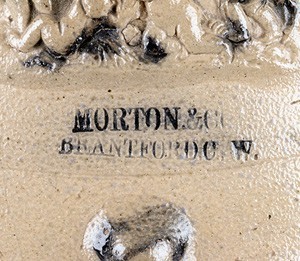
Detail of the impressed mark “MORTON & CO. / BRANTFORD C.W.” on the cooler illustrated in figure 1
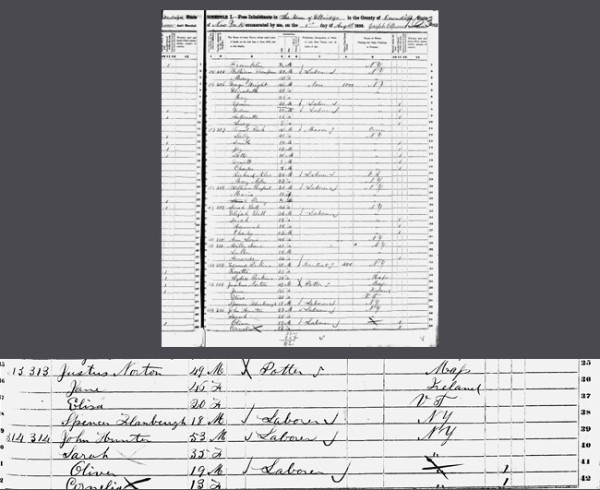
1850 Census, Town of Elbridge, County of Onondaga, New York, showing the name “Justus Norton.”
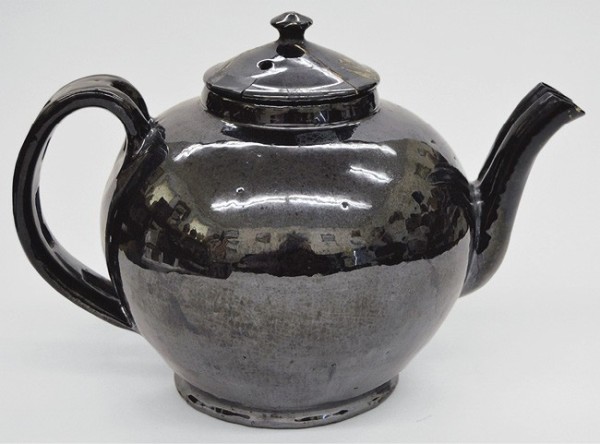
Teapot, Sanford S. Perry, Whately, Massachusetts, dated 1817. Black‑glazed earthenware. Dimensions not recorded. (Whately Historical Society; photo, Curtis Rice.) This double-handled, double-spouted teapot would have been made when Justus Morton was sixteen years old.

Detail of the bottom of the teapot illustrated in fig. 5 showing the inscribed date of 1817.
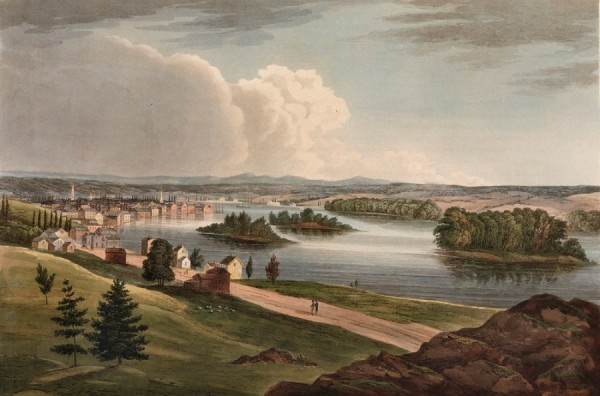
Troy from Mount Ida (No. 11 of The Hudson River Portfolio), published by Henry J. Megarey, New York, 1821–1822. Aquatint printed in color with hand-coloring. 14 1/16 x 20 3/16". (Courtesy, Metropolitan Museum of Art, The Edward W. C. Arnold Collection of New York Prints, Maps and Pictures, Bequest of Edward W. C. Arnold, 1954, 54.90.1274[11].) An image of Troy, New York, at the time Justus Morton arrived with Sanford and Julia Perry.

Detail of Map of the City of Albany: With Villages of Greenbush, East Albany & Bath, N.Y. , New York, E. Jacob, C.E., Sprague & Co., Albany, New York, 1857. (Lionel Pincus and Princess Firyal Map Division, New York Public Library Digital Collections.) According to Warren F. Broderick and William Bouck’s Pottery Works, Morton and Church’s 130 State St. address in Albany was near the old burying grounds (circled).
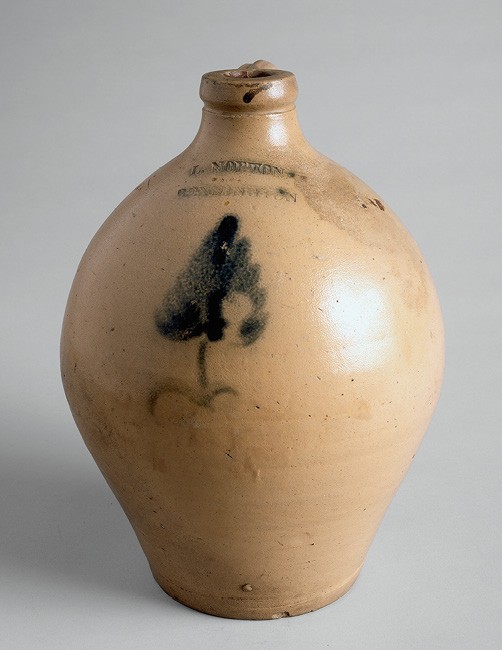
Jug, Luman Norton & Son, Bennington, Vermont, 1828–1833. Salt-glazed stoneware. H. 11 3/4". Stamped: l. NORTON / BENNINGTON (Courtesy, Bennington Museum, Gift of John Spargo.) Decorated with a cobalt flower or leaf.

Jug, Luman Norton & Son, Bennington, Vermont, 1833–1840. Salt-glazed stoneware. H. 13 3/4". Stamped: l. NORTON & SON / BENNINGTON (Courtesy, Bennington Museum, Gift of John Spargo.) Decorated with an ochre-colored flower

Jug, T. Crafts & Co., Whately, Massachusetts, 1833–1848. Salt-glazed stoneware. Dimensions not recorded. Stamped: T. CRAFTS & CO / WHATELY (Courtesy, Crocker Farm, Inc.)
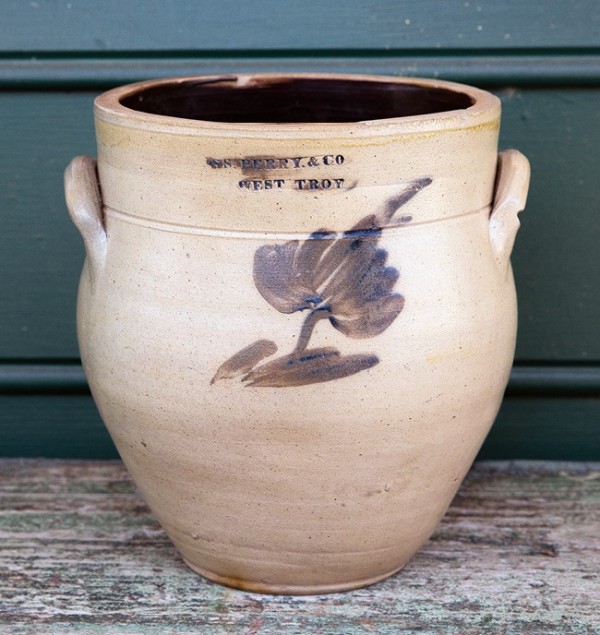
Jar, S. S. Perry & Co., West Troy, New York, ca. 1833–1835. Salt-glazed stoneware. H. 8 1/2". Stamped: SS. PERRY. & CO / WEST TROY (Private collection; photo, Robert Hunter.)
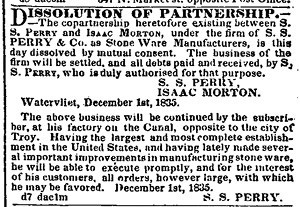
Newspaper notice, Albany Evening Journal, December 15, 1835, p. 3, announcing the end of the Perry/Morton partnership.

Detail of “Map of Baltimore, No. 26,” from Appleton’s Railroad and Steamboat Companion, Appleton & Co., New York, 1848. (John Hopkins Sheridan Libraries.) This detail shows the area in Baltimore near Eden and Pitt (Fayette) streets where Morton & Brotherton were operating 1840–1841.
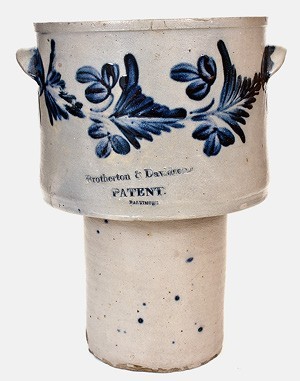
Water filter, Brotherton & Davidson, Baltimore, Maryland, ca. 1838. Salt-glazed stoneware. H. 15”. Stamped “Brotherton & Davidson. / PATENT. / BALTIMORE”. (Courtesy, Crocker Farm, Inc.)

Detail of the stamped mark on the water filter illustrated in fig. 15.

East View of Ithaca, Tompkins County, N.Y., Ithaca, New York, J. H. BuVord’s Lith., Boston, ca. 1836. Colored lithograph on paper. 11 7/16 x 18 1/2". (Mabel Brady Garvan Collection, Yale University Art Gallery, 1946.9.1752.) A view of Ithaca just a few years before Justus Morton’s arrival.

Photo of the Elijah Cornell pottery, on the southwest corner of Lincoln and Lake Streets, in Ithaca, New York, 1975. (Courtesy, Historic Ithaca.) This is the building in which Justus Morton was working in 1842. This photo was taken in 1975, before the building was renovated.
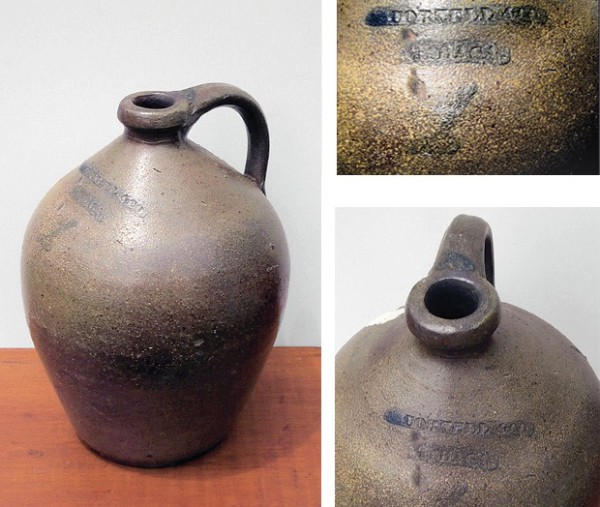
Jug and details, Elijah Cornell, ca. 1842–1850. Salt-glazed stoneware. H. 15". Mark: on shoulder, E CORNELL & CO / ITHACA (Courtesy, Sophia Kelly and Ted Sorbel; photo, Sophia Kelly.) This jug exhibits the characteristic muddy-looking clay body of this firm.

Jar, Morton & McBurney pottery, Jordan, New York, ca. 1848. Salt-glazed stoneware. H. 15". Mark: inscribed, on shoulder, MORTON & MCBURNEY / JORDAN. (Jordan Historical Society; photo, Sylvia Lovegren-Petras.) The only McBurney pots to have cobalt on the joins, as far as I know, are the Morton collaborations.
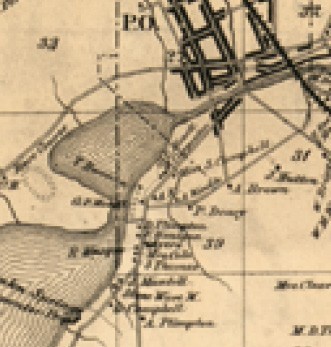
Detail from S. N. Beers, D. G. Beers, A. B. Prindle, F. Bourquin, Stone & Stewart, and Worley & Bracher, Map of Yates Co., New York: From Actual Surveys (Philadelphia: Published by Stone & Stewart, printed by Fred. Bourquin, 1865). (Courtesy, Library of Congress, https://www.loc.gov/item/2013593242/.) This map shows George Campbell’s place, near J. Mantell and Shem Thomas, two other well-known potters.
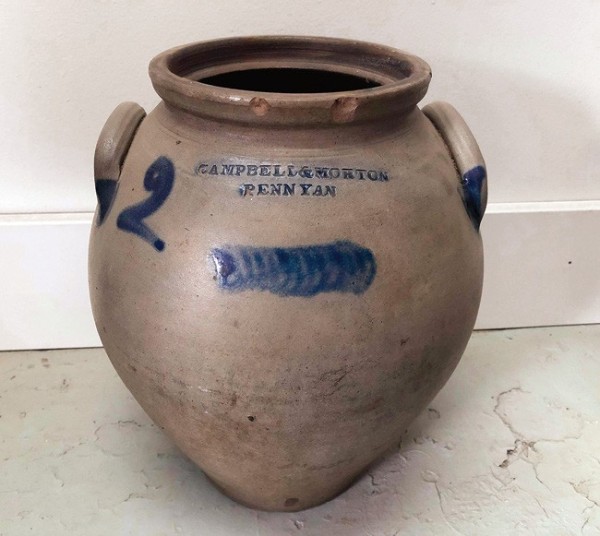
Jar, George Campbell and Justus Morton, Penn Yan, New York, ca. 1848. Salt-glazed stoneware. H. 12". Stamped: CAMPBELL & MORTON / PENN YAN; inscribed on shoulder, “2” (Courtesy, Bernie and Damian Davis; photo, Bernie Davis.) This two-gallon jar is the first Campbell & Morton piece to be discovered. A second example has recently surfaced and was sold at auction in 2020.

Detail of the jar illustrated in fig. 22.

Jug, Justus Morton, Jordan, New York, ca. 1840s. Salt-glazed stoneware. H. 15". Stamped: JORDAN. (Author’s collection; photo, Sylvia Lovegren-Petras.) Judging from its shape and markings, this jug may be the earliest known piece of Jordan stoneware. Joins are dabbed with cobalt. The mark has the typical Morton typeface.
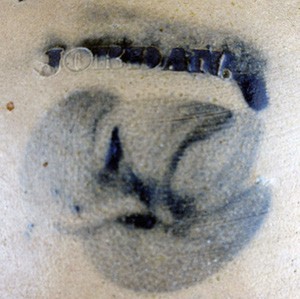
Detail of the mark on the jug illustrated in fig. 24.
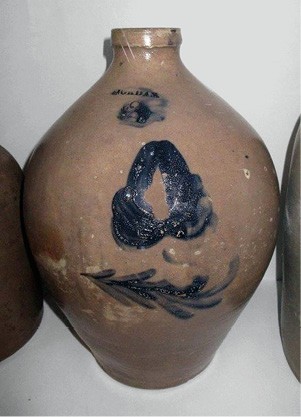
Jug, Justus Morton, Jordan, New York, ca. 1840s. Salt-glazed stone-
ware. Dimensions not recorded. (Jordan Historical Society; photo, Sylvia Lovegren-Petras.) Ovoid jug marked “Jordan” with Morton’s wreath and typeface, as well as typical “plow flower” cobalt motif.
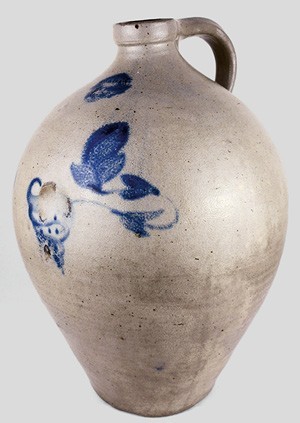
Jug, Justus Morton, Jordan, New York, ca. 1840s. Salt-glazed stoneware. H. 15 1/2". (Author’s collection; photo, Sylvia Lovegren-Petras.) The marked ovoid shape probably puts this one early in 1840s. The hopflower motif was popular with Morton. The jug also shows Morton’s typically casual approach, with a kiln mark right in the middle of the cobalt.
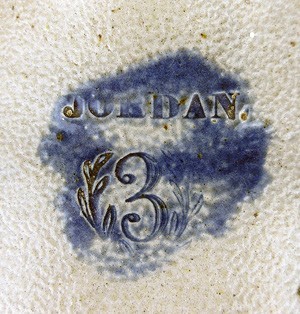
Detail of the jug illustrated in fig. 27 showing the classic Morton wreath and typeface.
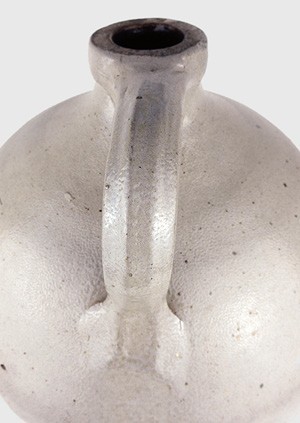
Detail of the jug illustrated in fig. 27 showing a typical “whale tail” Morton handle shape.
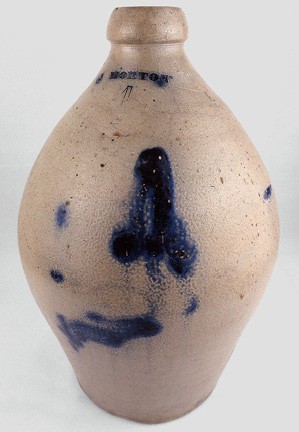
Jug, Justus Morgan, Jordan, New York, ca. 1840s. Salt-glazed stoneware. H. 12 1/2". Stamped: J MORTON (Author’s collection; photo, Sylvia Lovegren-Petras.)
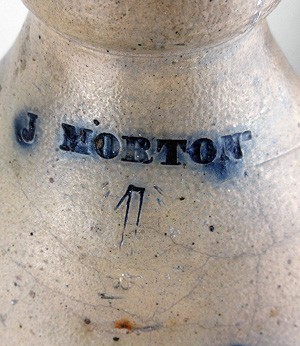
Detail of the J. Morton mark. The laurel wreath surrounding the number 1 is very faint.

Side view of the J. Morton jug illustrated in fig. 30 showing typical use of cobalt to highlight the joins.

Detail of the Onondaga County Mortgages book, Mortgages 1846–1847, vol. 54–55, image 69 of 644 (familysearch.org.) showing the mortgage of Justus Morton and Franklin S. Sheldon dated June 9, 1846.
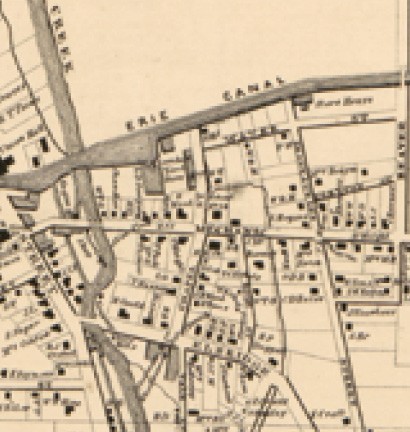
Detail from H. H. French and New York State Map and Atlas Survey, Map of Onondaga County, New York: showing military townships and their names, lot lines, numbers, and dimensions, with names of first proprietors . . . location of farm houses and names of owners, and separate plans of the city of Syracuse and all the villages in the county, on a large scale: from official records and new and accurate surveys ([Syracuse, N.Y.]: n.p., 1859). (Courtesy, Library of Congress, https://www.loc.gov/item/2013593263/.) This map shows where the Morton and Sheldon pottery was on the lot at the southeast corner of Mechanic and Rose Streets, marked here “J. McBurney.” (James McBurney lived and operated a pottery on this lot after Morton left.) There is an Erie Canal feeder stream on the east side of the property.

Jar, Justus Morton, Morton & Sheldon, Jordan, New York, ca. 1846. Salt-glazed stoneware. H. 10 1/2". Impressed: MORTON & SHELDON JORDAN. (Courtesy, Crocker Farm, Inc.) The inclusion of a man’s portrait is unusual for a Morton product. Could it be a self-portrait of Justus Morton?

Detail of the stoneware jar illustrated in fig. 35
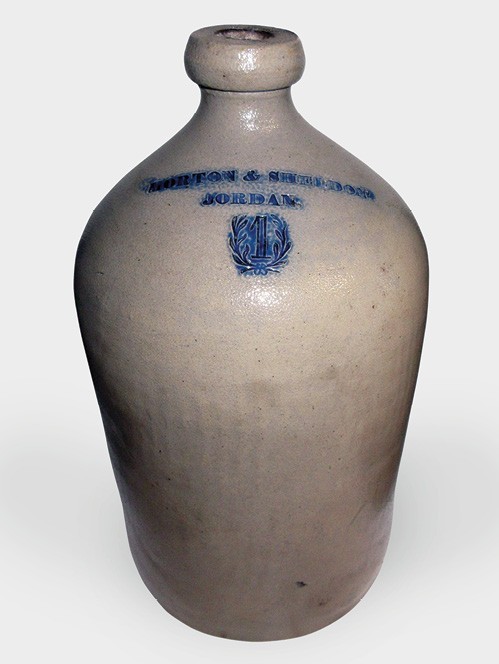
Jug, Justus Morton, Morton & Sheldon pottery, Jordan, New York, ca. 1846. Salt-glazed stoneware. Dimensions not recorded. Impressed: MORTON & SHELDON / JORDAN. (Courtesy, Jordan Historical Society; photo, Sylvia Lovegren-Petras.)
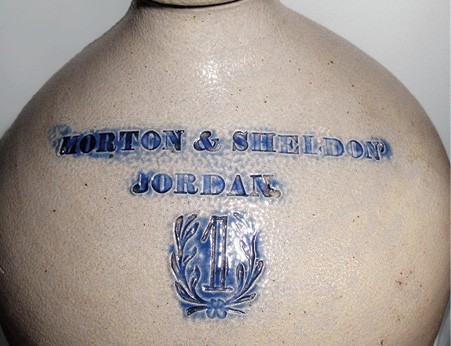
Detail of the jug illustrated in fig. 37 with a clear example of the typeface and the laurel wreath.
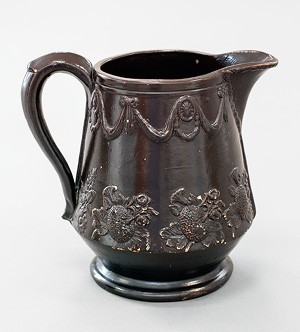
Pitcher, attributed to Justus Morton, Lyons, Wayne County, New York, ca. 1845. Albany slip-glazed stoneware. H. 10". (Courtesy, New York State Museum.)
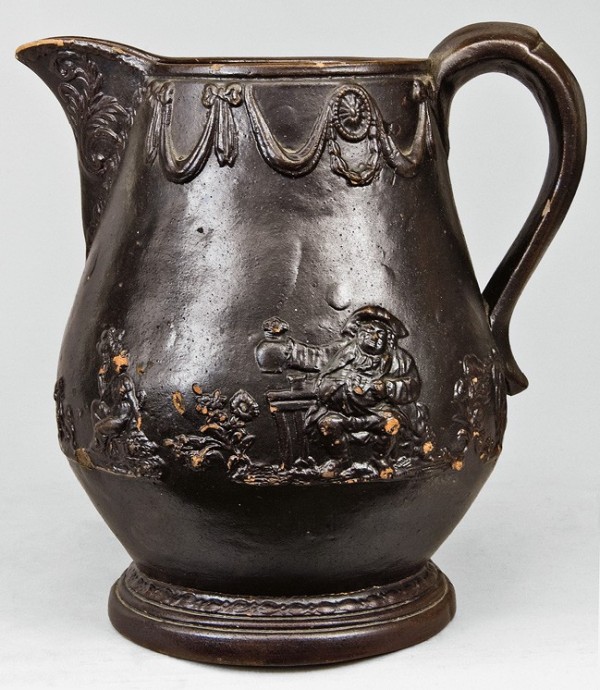
Pitcher, attributed to Justus Morgan, Jordan, New York, ca. 1842–1849. Albany slip stoneware. H. 10". (Courtesy, Crocker Farm, Inc.) Although there is no photograph of the maker’s mark available, I have handled this pitcher (or a twin) and it does bear Morton’s “JORDAN” stamp and is obviously very similar to the Lyons pitcher.
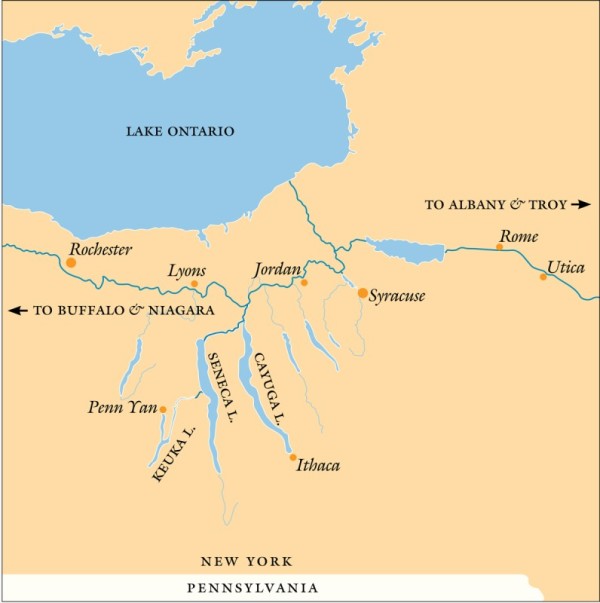
Map of the central New York
canals in the 1840s. (Drawn by Wynne Patterson.)
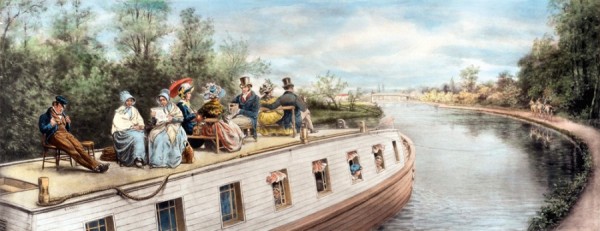
Edward Lamson Henry, Before the Days of Rapid Transit, 1893. From Charles M. Kurtz, Illustrations from the Art Gallery of the World’s Columbian Exposition (Philadelphia: George Barrie, 1893), p. 301. Hand-colored lithograph. Passengers as well as goods traveled on the Erie Canal in the 1800s. Morton very likely took a packet boat much like this one on some of his trips across upstate New York.

Jug, attributed to Justus Morton, Jordan, New York, 1843–1850. Salt-glazed stoneware. H. 12 1/2". (Courtesy, Jennifer and Rich Lung.) This recently discovered unmarked stoneware jug has not only typical central New York cobalt flowers on top but also Baltimore-style horizontal cobalt decoration below. The owners and I believe this to be an unmarked Morton jug.

The unmarked jug illustrated in fig. 43 next to a signed Morton/Jordan jug. (Courtesy, Jennifer and Rich Lung.)

Jug, Justus Morton, Jordan, New York, ca. 1842–1849. Salt-glazed stoneware. Dimensions not recorded. (Courtesy, Crocker Farm, Inc.) Ovoid stoneware jug with cobalt flower with Morton’s characteristic Jordan stamp and wreath around the “4”, with an unusual incised bird on one shoulder and an incised “V” on the other. This is the only known Morton piece featuring a bird and the only known Morton and Jordan piece with incising.

Detail of the jug illustrated in fig. 45 showing the unique incised bird.
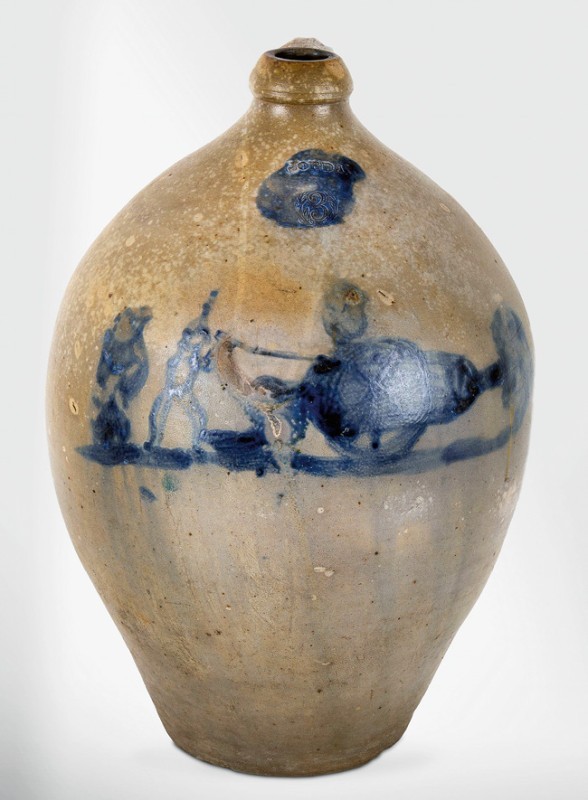
Jug, attributed to Justus Morton, Jordan, New York, ca. 1846–1848. Salt-glazed stoneware. H. 13". (David Tuxhill collection; photo, Carl Voellings, courtesy Antique Associates at West Townsend.) This jug has the characteristic Morton wreath around the capacity mark. Typically for Morton there is a kiln mark right on the cobalt and some fuzziness to the image. What is not characteristic is the extraordinary scene showing two men firing a canon. There is a good chance the illustration was inspired by the Mexican-American War (1846–1848).

Jar, attributed to Justus Morton, Jordan, New York, 1849. Salt-glazed stoneware. H. 13". (Courtesy, Howard Alligood, Arsenal Artifacts.) Unstamped Jordan jar, with some of Morton’s trademark flowers, dated 1849. This object is of particular interest because it establishes that Morton was potting in Jordan when he was supposed to have already moved to Canada.
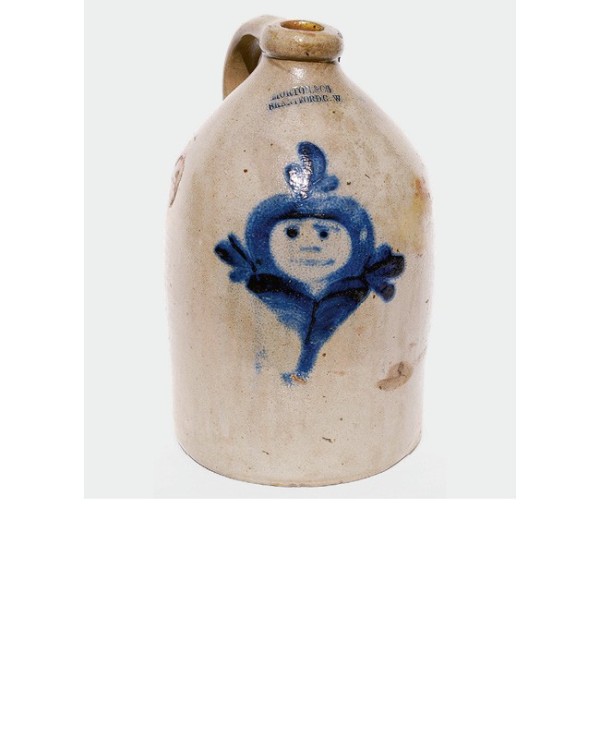
Jug, Justus Morton, Morton & Co., Brantford, Ontario, Canada, ca. 1854. Salt-glazed stoneware. Dimensions not recorded. (Courtesy, Scott Wallace, Maple Leaf Auctions, mapleleafauctions.com.) Most Morton Brantford ware was decorated with simple flowers, so this face is unusual.

Cake crock, Morton Goold & Co., Brantford, Ontario, Canada, ca. 1859. Salt-glazed stoneware. H. 7". Stamped: MORTON, GOOLD & C / BRANTFORD, C.W. (Courtesy, Scott Wallace, Maple Leaf Auctions, mapleleafauctions.com.) This mark was in use for only a few months in 1859 so it is scarce in and of itself, but the small cake crock form is also very unusual for Morton, making it very desirable for Brantford collectors.
